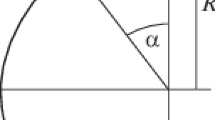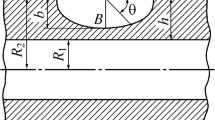Abstract
A determination is made of the load-carrying capacity of an oil pipeline with defects with allowance for the changes in the radius, thickness, and ductility properties of the constituent steels and the biaxial nature of the loading. The use of a fracture criterion connected with loss of plastic stability by the pipe is substantiated. This criterion is refined with consideration of the biaxial character of the load and the parameters of a longitudinal crack in the pipe. New analytical relations are derived for engineering calculations of the ultimate strength of thin-walled cylindrical pressure vessels, and a coefficient expressing the effect of the dimensions of the surface crack is refined for these formulas, Examples are presented to illustrate the calculation of the force exerted by a hydraulic expander in the last forming operation for large-diameter pipe. Also, practical recommendations are given on determining hydraulic testing regimes, load-carrying capacity, working pressure for oil pipelines.
Similar content being viewed by others
Literature cited
GOST 3845-65. Pipes. Methods of Testing with Hydraulic Pressure.
B. A. Shcheglov, “Evaluating the mechanical properties of sheet metals in hydraulic tests,” in: Investigation of Processes in the Plastic Deformation of Metals [in Russian] (1965), pp. 24–29.
A. N. Monoshkov et al., “Plastic stability and its role in evaluating the strength of pipes,” Proizvod. Trub c Pokrytiyami. Otdelka i Kontrol' Kachestva Trub, No. 1, 48–52 (1973).
Rover and Rolf, “Effect of the strain-hardening exponent and stress concentration on the character of failure of pressure vessels,” J. Fluid Mech., No. 4, 82–87 (1974).
B. A. Shcheglov, N. L. Kolesnikov, and F. I. Ruzanov, “Determination of maximum uniform elongation in uniaxial tension tests,” in: Investigation of Processes in Plastic Deformation [in Russian] (1965), pp. 68–73.
V. V. Chelyshev, V. G. Brudukovskii, B.N. Gubashev, and V. V. Kirichenko, Probl. Prochn., No. 2, 32–36 (1978).
A. D. Tomlenov, Mechanics of Processes in the Shaping of Metals [in Russian], Mashgiz, Moscow (1963).
N. L. Svensson, “The bursting pressure of cylindrical and spherical vessels,” J. Appl. Mech., No. 3, 89–96 (1958).
A. Ya. Krasovskii, I. V. Orynyak, and V. M. Torop, “Ductile fracture of cylindrical bodies with axial cracks loaded by internal pressure,” Probl. Prochn., No. 2, 16–20 (1990).
V. Yu. Zarukhin and A. A. Ost-semin, “Calculation of the limiting state of banded pipes,” ibid., No. 1, 76–81.
R. S. Zainullin, “Load-carrying capacity of welded vessels with sharp surface defects,” Svar. Proizvod., No. 3, 5–7 (1981).
A. Daffy. R. Eiber, and W. Maxie, “Behavior of defects in pressure vessels,” in: New Methods of Evaluating the Resistance of Metals to Brittle Fracture [Russian translation], Mir, Moscow (1972), pp. 301–332.
E. Thompson, J. Yang, and S. Kobayashi, Mechanics of Plastic Deformation in the Shaping of Metals [Russian translation], Mashinostroenie, Moscow (1969).
M. V. Shakhmatov, V. V. Erofeev, A. A. Ost-semin, and V. A. Lupin, “Effect of defects located on the fusion line on the static strength of welds on large-diameter pipes,” Probl. Prochn., No. 8, 111–116 (1984).
V. K. Kolomenskii and L. M. Shifrin, “Determination of pipe-bursting pressure in hydraulic expanders,” Proizvod. Svarnykh Besshovnykh Trub, No. 2, 59–63 (1973).
A. P. Gusenkov and A. S. Aistov, “Study of the low-cycle strength of large-diameter pipes in gas and oil pipelines,” Mashinovedenie, No. 3, 61–70 (1975).
Author information
Authors and Affiliations
Additional information
Translated from Problemy Prochnosti, No. 12, pp. 51–59, December, 1993.
Rights and permissions
About this article
Cite this article
Ost-semin, A.A., Zavarukhin, V.Y. Strength of an oil pipeline with surface defects. Strength Mater 25, 898–905 (1993). https://doi.org/10.1007/BF00774637
Received:
Issue Date:
DOI: https://doi.org/10.1007/BF00774637




